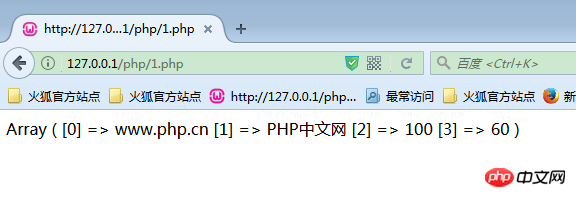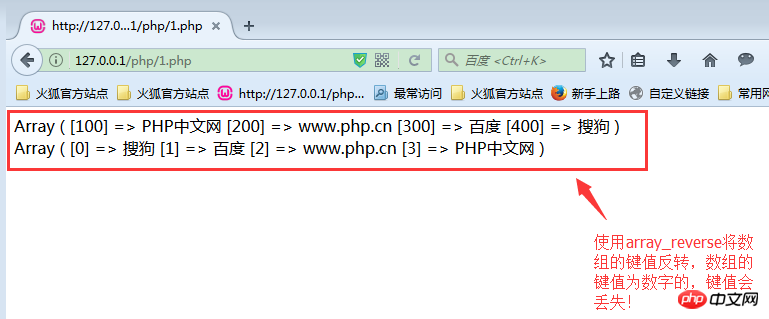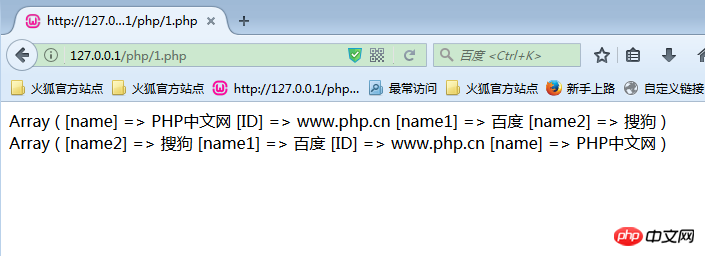 Backend Development
Backend Development
 PHP Tutorial
PHP Tutorial
 Detailed explanation of examples of random shuffling and reverse ordering of PHP arrays
Detailed explanation of examples of random shuffling and reverse ordering of PHP arrays
Detailed explanation of examples of random shuffling and reverse ordering of PHP arrays
Random shuffling and reverse order of PHP arrays
In the first two articles "How to sort PHP arrays" and " PHP Array Reverse Order" introduces two sets of functions, one in ascending order and one in reverse order (descending order). Today, in this article, we will introduce to you the random order and reverse order of arrays!
1. What is random disorder? (shuffle)
#shuffle is to disrupt the array.
Use the shuffle function to randomly sort the elements in the array.
The shuffle syntax structure is as follows:
bool shuffle ( array &$array )
| Parameters | Description |
| array | Required. Specifies the array to adapt to. |
This function scrambles (randomly arranges the order of cells) an array. It uses a pseudo-random number generator and is not suitable for cryptography situations.
shuffle instance usage:
Let’s take an example to explain the shuffle function in detail. The specific code is as follows:
<?php
header("Content-Type:text/html; charset=utf-8");
$arr=array("name" => "PHP中文网", "url" => "www.php.cn", "tom" => "100","hank" => "60");
shuffle($arr); // 将数组的值随机排序
print_r($arr);
?>The output result is:

The above example will output different results every time you refresh the browser. I won’t take more screenshots here. You can try it locally!
Note: After the associative array is shuffled, the keys will be lost, as you should be able to see from the above example!
2. What is reverse order? (array_reverse)
array_reverse — Returns an array with the reverse order of the cells. Reverse order is to reverse the order of each element in an original array,
The syntax format of array_reverse is as follows:
array array_reverse ( array $array [, bool $preserve_keys = false ] )
array_reverse() accepts array array as input and returns a new array with the cells in reverse order. If preserve_keys is TRUE, the original key names are retained.
Instructions:
1. Reverse order ≠ Descending order
2. If The array is an associative array
When the key is a character, the reverse order will not be affected, the key will still be retained
When the key is a number, after the reverse order The default keys will be reset to 0, 1, 2...
When the second parameter is true, the keys are numbers, and the numeric keys are retained in reverse order
Let’s look at the example code of when the key is a number:
<?php
header("Content-Type:text/html; charset=utf-8");
$arr=array("100" => "PHP中文网", "200" => "www.php.cn", "300" => "百度","400" => "搜狗");
$array = array_reverse($arr);//数组反序,将数组的元素反转
print_r($arr);
echo "<br>";
print_r($array);
?>The output result is:

The key is Keep the key value when numbersSample code:
<?php
header("Content-Type:text/html; charset=utf-8");
$arr=array("100" => "PHP中文网", "200" => "www.php.cn", "300" => "百度","400" => "搜狗");
$array = array_reverse($arr,true);//数组反序,将数组的元素反转
print_r($arr);
echo "<br>";
print_r($array);
?>The output result is:

As can be seen from the above code, the key is When numbers are used, the key value is retained, which means the second parameter of array_reverse is true!
The key is when the key is a characterSample code:
<?php
header("Content-Type:text/html; charset=utf-8");
$arr=array("name" => "PHP中文网", "ID" => "www.php.cn", "name1" => "百度","name2" => "搜狗");
$array = array_reverse($arr);//数组反序,将数组的元素反转
print_r($arr);
echo "<br>";
print_r($array);
?>The output result is:

array_reverse function When the array is reversed, if the key value is a string, the key value will be retained!
Note: When using the array_reverse function, the original array will not be affected, and a new array will be returned!
In this article we introduce the reverse order and disorder of the array. In the next article, we will introduce the equal division, replacement and interception of arrays. For detailed introduction, please read "Interception, equal division and replacement of partial arrays of PHP arrays"!
【Related tutorial recommendations】
Related topic recommendations: "php array (Array)"
Related video course recommendations: "Other array functions: array_rand()/array_sum()/shuffle()/range()》
The above is the detailed content of Detailed explanation of examples of random shuffling and reverse ordering of PHP arrays. For more information, please follow other related articles on the PHP Chinese website!

Hot AI Tools

Undresser.AI Undress
AI-powered app for creating realistic nude photos

AI Clothes Remover
Online AI tool for removing clothes from photos.

Undress AI Tool
Undress images for free

Clothoff.io
AI clothes remover

Video Face Swap
Swap faces in any video effortlessly with our completely free AI face swap tool!

Hot Article

Hot Tools

Notepad++7.3.1
Easy-to-use and free code editor

SublimeText3 Chinese version
Chinese version, very easy to use

Zend Studio 13.0.1
Powerful PHP integrated development environment

Dreamweaver CS6
Visual web development tools

SublimeText3 Mac version
God-level code editing software (SublimeText3)

Hot Topics
 1664
1664
 14
14
 1423
1423
 52
52
 1321
1321
 25
25
 1269
1269
 29
29
 1249
1249
 24
24
 PHP and Python: Comparing Two Popular Programming Languages
Apr 14, 2025 am 12:13 AM
PHP and Python: Comparing Two Popular Programming Languages
Apr 14, 2025 am 12:13 AM
PHP and Python each have their own advantages, and choose according to project requirements. 1.PHP is suitable for web development, especially for rapid development and maintenance of websites. 2. Python is suitable for data science, machine learning and artificial intelligence, with concise syntax and suitable for beginners.
 PHP in Action: Real-World Examples and Applications
Apr 14, 2025 am 12:19 AM
PHP in Action: Real-World Examples and Applications
Apr 14, 2025 am 12:19 AM
PHP is widely used in e-commerce, content management systems and API development. 1) E-commerce: used for shopping cart function and payment processing. 2) Content management system: used for dynamic content generation and user management. 3) API development: used for RESTful API development and API security. Through performance optimization and best practices, the efficiency and maintainability of PHP applications are improved.
 PHP: A Key Language for Web Development
Apr 13, 2025 am 12:08 AM
PHP: A Key Language for Web Development
Apr 13, 2025 am 12:08 AM
PHP is a scripting language widely used on the server side, especially suitable for web development. 1.PHP can embed HTML, process HTTP requests and responses, and supports a variety of databases. 2.PHP is used to generate dynamic web content, process form data, access databases, etc., with strong community support and open source resources. 3. PHP is an interpreted language, and the execution process includes lexical analysis, grammatical analysis, compilation and execution. 4.PHP can be combined with MySQL for advanced applications such as user registration systems. 5. When debugging PHP, you can use functions such as error_reporting() and var_dump(). 6. Optimize PHP code to use caching mechanisms, optimize database queries and use built-in functions. 7
 The Enduring Relevance of PHP: Is It Still Alive?
Apr 14, 2025 am 12:12 AM
The Enduring Relevance of PHP: Is It Still Alive?
Apr 14, 2025 am 12:12 AM
PHP is still dynamic and still occupies an important position in the field of modern programming. 1) PHP's simplicity and powerful community support make it widely used in web development; 2) Its flexibility and stability make it outstanding in handling web forms, database operations and file processing; 3) PHP is constantly evolving and optimizing, suitable for beginners and experienced developers.
 PHP vs. Python: Understanding the Differences
Apr 11, 2025 am 12:15 AM
PHP vs. Python: Understanding the Differences
Apr 11, 2025 am 12:15 AM
PHP and Python each have their own advantages, and the choice should be based on project requirements. 1.PHP is suitable for web development, with simple syntax and high execution efficiency. 2. Python is suitable for data science and machine learning, with concise syntax and rich libraries.
 PHP and Python: Code Examples and Comparison
Apr 15, 2025 am 12:07 AM
PHP and Python: Code Examples and Comparison
Apr 15, 2025 am 12:07 AM
PHP and Python have their own advantages and disadvantages, and the choice depends on project needs and personal preferences. 1.PHP is suitable for rapid development and maintenance of large-scale web applications. 2. Python dominates the field of data science and machine learning.
 PHP vs. Other Languages: A Comparison
Apr 13, 2025 am 12:19 AM
PHP vs. Other Languages: A Comparison
Apr 13, 2025 am 12:19 AM
PHP is suitable for web development, especially in rapid development and processing dynamic content, but is not good at data science and enterprise-level applications. Compared with Python, PHP has more advantages in web development, but is not as good as Python in the field of data science; compared with Java, PHP performs worse in enterprise-level applications, but is more flexible in web development; compared with JavaScript, PHP is more concise in back-end development, but is not as good as JavaScript in front-end development.
 PHP and Python: Different Paradigms Explained
Apr 18, 2025 am 12:26 AM
PHP and Python: Different Paradigms Explained
Apr 18, 2025 am 12:26 AM
PHP is mainly procedural programming, but also supports object-oriented programming (OOP); Python supports a variety of paradigms, including OOP, functional and procedural programming. PHP is suitable for web development, and Python is suitable for a variety of applications such as data analysis and machine learning.



